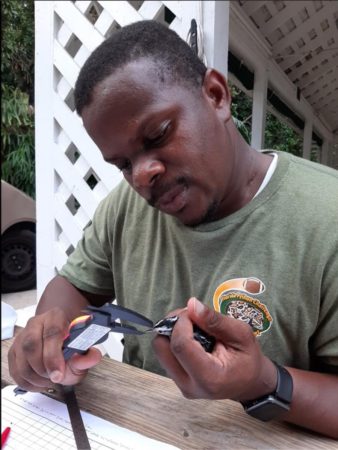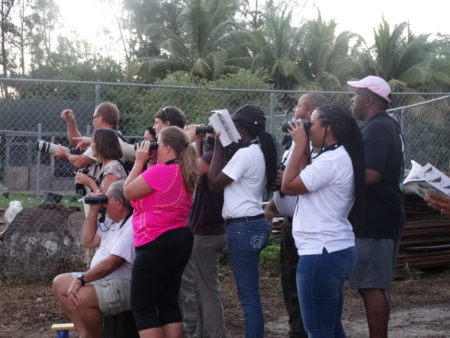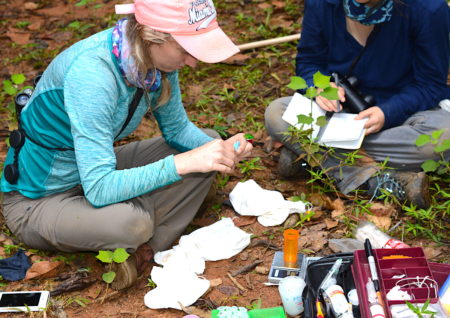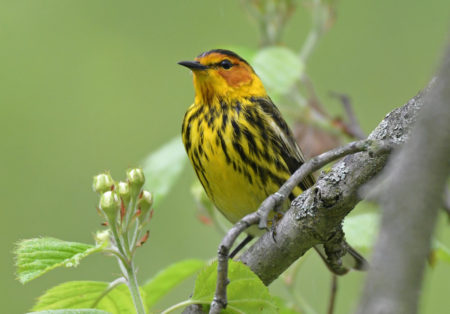
BirdsCaribbean is excited to announce that we were recently awarded a Neotropical Migratory Bird Conservation Act (NMBCA) Grant! With the help of matching funds from our partners, we were awarded US$200,000 to implement a project that will increase capacity to monitor landbirds in the Caribbean!
BirdsCaribbean has several successful bird monitoring initiatives, including our Caribbean Waterbird Census (CWC) and Caribbean Seabirds Monitoring Manual. These initiatives have provided novel information and helped designate and protect sites that are crucial to the survival of bird populations. For example, as a result of CWC monitoring, Cargill Salt Ponds in Bonaire was designated a Western Hemisphere Shorebird Reserve Network site in 2018. We have identified dozens more sites that likely qualify, and are following up to gather additional data to support their nomination.
So the next step, of course, is landbirds! Landbirds spend the majority of their lives over land, and include birds like parrots, hummingbirds, songbirds, woodpeckers, todies, and raptors. Many landbird species are declining, including our resident and endemic birds, as well as over 100 migratory species. Monitoring is essential to filling gaps in our knowledge about the status, trends, and habitat use of their populations.
Our new Landbird Monitoring project will increase capacity to monitor landbirds in the Caribbean using three different, yet complementary, monitoring tools: standardized surveys, bird banding, and the Motus Wildlife Tracking System.
Caribbean Landbird Monitoring (CLM) Network

Currently, there is not a standardized set of protocols for observing and recording landbirds in the Caribbean. The Programa de América Latina para las Aves Silvestres (PROALAS) Manual was developed in Latin America, and was designed specifically with the tropics in mind. We plan to further adapt these protocols to fit our unique Caribbean ecosystems. The multi-level survey protocols in the manual also incorporate the use of eBird, which will help us get a more complete picture of how our Caribbean birds are faring! Standardized surveys are one of the best ways to monitor landbirds, and entering survey data into eBird ensures its longevity.
These standard protocols will be made available as soon as they are ready, and we will be offering several training workshops to our Caribbean colleagues to get hands-on experience using them.
Caribbean Bird Banding (CBB) Network

Bird banding is a monitoring technique used throughout the world to gain valuable demographic and health information from birds in the hand. While surveys give us a broader picture of landbird communities, banding gives us deeper insights into how these birds are doing, allowing for assessments of body condition, survival, and more. Birds are captured and given bands with unique identifying numbers so they’ll be recognized if they are captured again, no matter where they travel to. There are several ongoing and pending bird banding operations in the Caribbean, and we are hoping to unite them under the Caribbean Bird Banding (CBB) Network!
As part of the CBB Network, we will create Caribbean bird bands and distribute them to permitted and qualified banders in the region. Our system will be similar to the USGS system, which no longer distributes bands outside of the U.S. Our bands will be stamped with contact information so that anyone can report a bird band or banded bird they find. The banding network will also include a database so that banding data can be collected consistently across the islands, and compiled to easily find recaptured birds.
Joining the network will connect banders to the other banding operations throughout the Caribbean, enabling them to discuss, share information, and learn about topics like banding techniques and molt patterns. NMBCA funding will allow us to develop the CBB Network and also offer training workshops and internships so people can learn how to band birds and improve their banding techniques.
CLICK ON EACH PHOTO BELOW TO VIEW LARGER.
Motus Wildlife Tracking in the Caribbean

Motus (Latin for movement) is a collaborative research network managed by Birds Canada that allows us to better understand bird migration patterns. The powerful tracking technology uses automated radio telemetry stations to detect tagged birds (and other small flying animals like bats and insects) as they move across the landscape.
Motus stations have been popping up all over the Eastern U.S. and Canada, and the network is starting to expand in Central and South America. The Caribbean is one of the remaining empty gaps in the network – but that’s soon to change! Thanks to NMBCA, we now have enough funding to put Motus stations on multiple Caribbean islands and train local conservation groups to help maintain them! We’re also going to tag some of our shared migratory birds on their Caribbean wintering grounds to get a better sense of where exactly they migrate to.
In addition to the Motus component of our Landbird Monitoring project, we’ve accelerated our efforts to expand the network in the Caribbean through our Caribbean Motus Collaboration. Special thanks to everyone who participated and donated to this initiative during our Global Big Day campaign!
Thank you!
We are very excited to officially launch our Caribbean Landbird Monitoring project in partnership with our widespread collaborators! We look forward to working with you!
If you are interested in getting involved, be sure to join our BirdsCaribbean Monitoring Working Group listserv to receive updates and learn about upcoming training workshops and other opportunities. Simply send an email to MonitoringWG+subscribe@BirdsCaribbean.groups.io (Note: this will also subscribe your email address to our main BirdsCaribbean listserv).
If you have specific questions, please email the Project Manager, Maya Wilson: Maya.Wilson@BirdsCaribbean.org








